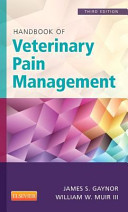Handbook of Veterinary Pain Management, 3rd Edition

Již třetí vydání oblíbeného manuálu poskytuje přehled o zvládnutí bolesti ve veterinární medicíně. Uvedeny jsou nové poznatky o vyhodnocení bolesti, nových farmaceutických produktů a možnosti zvládnutí bolesti. Nověji jsou uvedeny kapitoly o zvládnutí bolesti u ptáků a exotických zvířat, možnostech využití alternativní medicíny a možnostech využití při rehabilitaci zvířat. Formát publikace umožňuje rychlý přehled a vyhledání požadované informace. Dávky léčiv jsou uvedeny v přehledných tabulkách, kapitoly jsou bohate ilustrovány černobílými fotografiemi a perovkami. Publikace je obohacena o klinické případy s uvedením používaných preparátů a možnostech léčby.
Autor: James S. Gaynor, DVM, MS, DACVA, DAAPM, Certified Veterinary Acupuncturist, International Veterinary Acupuncture Society; Director, Animal Anesthesia and Pain Management Center, Colorado Springs, CO and William W. Muir, DVM, PhD, Regional Director, American Academy of Pain Management, Veterinary Clinical Pharmacology Consulting Services, Columbus, OH
| Nakladatel | Elsevier Saunders |
|---|---|
| ISBN | 9780323089357 |
| Vydání | III. vydání 2014 |
| Vazba | brožovaná |
| Počet stran | 620 |
Trust the Handbook of Veterinary Pain Management, 3rd Edition to help you meet the increasing need for effective pain management in the animals you treat. This user-friendly guide contains the most up-to-date and clinically relevant information on analgesic drugs and managing pain in dogs, cats, birds, reptiles, ferrets, and rabbits. It specifically covers the areas of pain assessment, pharmaceutical and non-pharmaceutical treatment options, guidelines for managing acute and chronic pain, and unique aspects of pain management.
The latest information on complementary and alternative strategies for pain managementoffers the guidance to help you incorporate non-pharmacologic treatments into their pain management programs.
Numerous boxes and tables summarize pharmacologic protocols and clinical applications, with dosages, indications, contraindications, and side effects to provide you with the comprehensive drug information needed to find the most effective and appropriate treatment.
User-friendly format helps you quickly and easily find essential information.
Case studies illustrating realistic clinical scenarios help you learn how to assess and manage pain in the clinical setting.
NEW! Eight new chapters include the latest information on:
the human-animal bond
local and regional techniques
preventive and multimodal analgesia
energy modalities
acupuncture
physical examination with emphasis on isolating and locating pain
therapeutic goals
pain in laboratory animals
NEW! Completely updated drug information, with new agents, doseforms, and routes provides the most current pain management therapies for use in the clinical setting.
NEW! Expanded sections on the cat and exotics address the growing popularity of these pets by providing additional species-specific information.
| 1. Pain Management and the Human-Animal Bond | 3 |
| 2. Nociception and Pain Mechanisms | 10 |
| 3. Pain and Stress: Stress-Induced Hyperalgesia and Hypoalgesia | 42 |
| 4. Definitions of Terms Describing Pain | 61 |
| 5. Assesing Pain: Pain Behaviors | 67 |
| 6. Health-Related Quality of Life Measurement | 98 |
| 7. Overview of Drug Administred to Treat Pain | 113 |
| 8. Nesteroidal Anti-inflamatory Drugs | 142 |
| 9. Opioids | 161 |
| 10. Alpha-agonists | 196 |
| 11. Local Anesthetics | 216 |
| 12. Local and Regional Anesthetic Techniques | 224 |
| 13. Glucocorticosteroids | 266 |
| 14. Alternative Drugs and Novel Therapies Used ti Treat Pain | 280 |
| 15. Factors Influencing Analgesic Drug selection, Dose, and Routes of Drug Administrations | 302 |
| 16. Drug Interactions, Analgesic, Protocols and Their Consequeces and Analgesic Drug Antagonism | 335 |
| 17. Energy Modalities: Therapeutic Laser and Pulsed Electromagnetic Field Therapy | 356 |
| 18. Acupuncture | 365 |
| 19. Physical Therapy and Rehabilitation in Dogs | 383 |
| 20. Physical Examination with Emphasis on Isolating and Detecting Pain | 422 |
| 21. Therapeutic Goals | 428 |
| 22. Acute Pain Management: A case-Based Aproach | 444 |
| 23. Chronic Pain Cases | 472 |
| 25. Rabbit and Ferrets-specific Considerations | 517 |
| 26. Bird-Specific Considerations Recognizing Pain Behavior in Pet Birds | 536 |
| 27. Reptile-Specific Considerations | 555 |
| 28. Regulations Regarding Pain and Distress in Laboratory Animals | 567 |
| Appendix | 577 |
| Drug Used to treat Pain, Pain-Related Anxiety and Anesthesia-Related Side Effects as Described in thid Handbook | 577 |
| Index | 589 |